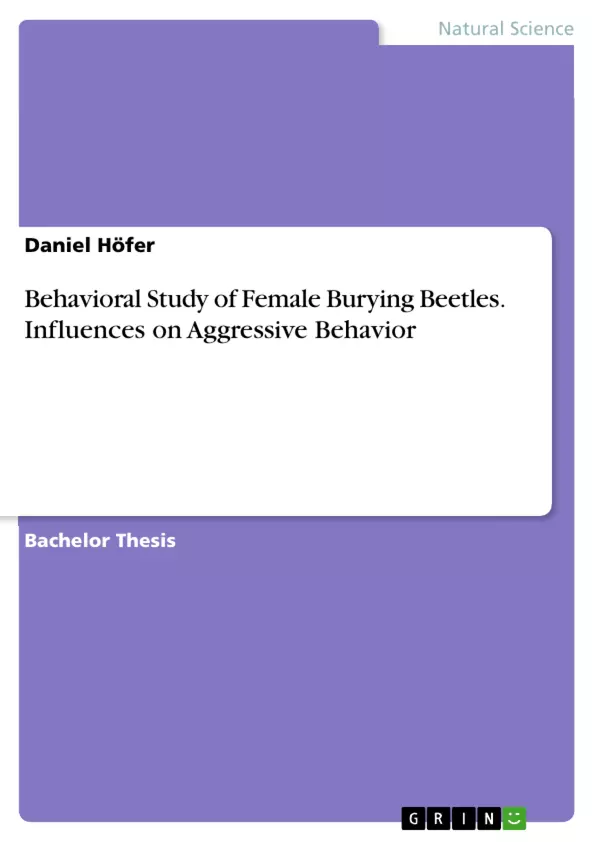In this bachelor thesis the behavior of burying beetles (Nicrophorus vespilloides) was further investigated through a detailed behavioral study. In this study fighting videos between N. vespilloides residents (females with larvae and a carcass) and intruders (females without larvae and a carcass) were evaluated. Half of the residents were treated with a FMRFamide solution and the other half there treated with a saline solution (control group). The FMRFamide treatment results in a more aggressive behavior in the females. This reaffirm the role of FMRFamide as an agent which has an influence in triggering aggressive behavior in burying beetles.
Aggressive behavior is widespread among animals and crucial for survival and passing on their genes. Aggressive behavior therefore mostly occurs during competition for resources like mating partners, nutrition and territory. Hence the burying beetle Nicrophorus vespilloides also use aggressive behavior to protect its brood. In previous studies the JH III (Juvenile Hormone III) titer in burying beetles could be identified to be causal for brooding behavior and therefore also causal for the increased aggression during breeding time. The regulation of JH titer in insects is unclear to this moment. Peptides with a tetrapeptic ending like FMRFamide have been suggested in the past to play a role in the regulation. Hence the effect of FMRFamide as a potential JH releasing factor also was investigated in burying beetles. This effect could not be confirmed to this date however a correlation between aggression and FMRFamide was found.
Inhaltsverzeichnis (Table of Contents)
- Abstract
- Introduction
- Material and methods
- Results
- Duration of behaviors
- Chronological occurrence of behaviors
- Comparison of the behaviors occurring in the different treatment groups
- Separate analysis of occurrence in each individual behavior
- Discussion
- Acknowledgment
- References
Zielsetzung und Themenschwerpunkte (Objectives and Key Themes)
This bachelor thesis investigates the role of FMRFamide in the aggressive behavior of female burying beetles, Nicrophorus vespilloides. The study aims to analyze the behavioral responses of resident females, both treated with FMRFamide and a control group, when confronted with intruding females. The study seeks to understand the potential influence of FMRFamide on aggression levels and to further clarify the relationship between this peptide and aggressive behavior in burying beetles.
- Influence of FMRFamide on aggressive behavior in female burying beetles
- Behavioral analysis of resident and intruder interactions
- Role of FMRFamide as a potential JH releasing factor
- Comparison of aggression levels between FMRFamide-treated and control groups
- Significance of aggressive behavior in burying beetle survival and reproduction
Zusammenfassung der Kapitel (Chapter Summaries)
- Abstract: This chapter provides a concise overview of the study, focusing on the role of FMRFamide in regulating aggressive behavior in female burying beetles. The study aims to investigate the impact of FMRFamide treatment on aggression levels and its potential link to Juvenile Hormone III (JH III) titer.
- Introduction: This chapter provides background information on burying beetles, their behavior, and the significance of parental care in their survival and reproduction. It discusses the importance of aggressive behavior in resource competition and highlights the potential role of FMRFamide as a regulator of aggressive behavior. This section also introduces the concept of JH III as a key factor in the regulation of parental care and its possible link to aggression.
Schlüsselwörter (Keywords)
This study focuses on the following key terms and concepts: burying beetles, Nicrophorus vespilloides, aggressive behavior, FMRFamide, Juvenile Hormone III (JH III), parental care, breeding behavior, intra- and interspecific competition, resident-intruder interactions, behavioral analysis, video analysis.
- Quote paper
- Daniel Höfer (Author), 2016, Behavioral Study of Female Burying Beetles. Influences on Aggressive Behavior, Munich, GRIN Verlag, https://www.grin.com/document/924862



